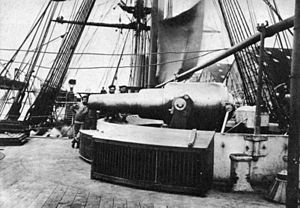RML 11-inch 25-ton gun
| Ordnance RML 11-inch 25-ton gun | |
|---|---|
 Disappearing gun on HMS Temeraire in firing position | |
| Type | Naval gun Coast defence gun |
| Service history | |
| In service | 1867–1903 |
| Used by | Royal Navy |
| Wars | Bombardment of Alexandria |
| Production history | |
| Manufacturer | Royal Arsenal |
| Unit cost | £1,589 (18751)[1] |
| Variants | Mk I, Mk II |
| Specifications | |
| Mass | 25 long tons (25,000 kg) |
| Barrel length | 145 inches (3.7 m) (bore + chamber)[2] |
| Shell | 532 to 543 pounds (241.3 to 246.3 kg) Palliser, Common, Shrapnel |
| Calibre | 11-inch (279.4 mm) |
| Muzzle velocity | 1,360 feet per second (410 m/s)[3] |
RML 11-inch 25-ton guns were large rifled muzzle-loading guns used as primary armament on British battleships and for coastal defence. They were effectively the same gun as the RML 12-inch 25-ton gun, bored to 11 inches instead of 12.
Design[edit]

Mark I was introduced in 1867. Mark II was introduced in 1871 using the simpler and cheaper "Fraser" gun construction method which had proved successful with the RML 9-inch 12-ton Mk IV gun. [4]
In 1874 the process of development made a "New Eighty-one Ton Gun" available in Woolwich.[5]
[edit]
Guns were mounted on:
- HMS Alexandra, commissioned 1877.
- HMS Temeraire, commissioned 1877.
Ammunition[edit]
When the gun was first introduced projectiles had several rows of "studs" which engaged with the gun's rifling to impart spin. Sometime after 1878, "attached gas-checks" were fitted to the bases of the studded shells, reducing wear on the guns and improving their range and accuracy. Subsequently, "automatic gas-checks" were developed which could rotate shells, allowing the deployment of a new range of studless ammunition. Thus, any particular gun potentially operated with a mix of studded and studless ammunition.
The gun's primary projectile was 536–543 lb (243–246 kg) "Palliser" armour-piercing shot, which were fired with a "Battering charge" of 85 lb (39 kg) of "P" (gunpowder) or 70 lb (32 kg) of "R.L.G." (gunpowder) for maximum velocity and hence penetrating power. Shrapnel and Common (exploding) shells weighed 532–536 lb (241–243 kg) and were fired with a "Full charge" of 60 lb (27 kg) "P" or 50 lb (23 kg) "R.L.G.".[6]
See also[edit]
Surviving examples[edit]


- Two Mark II guns, number 12 and 14 at Fort George, Bermuda : [2]
- Mark II gun number 30 at Fort Nelson, Portsmouth, UK
- Three Mark II guns on Drake's Island, Plymouth, UK
- Four guns outside Fort Saint Elmo, Malta
- Mark II gun dated 1871 outside Fort St. Catherine, Bermuda
Notes[edit]
- ^ [1]
- ^ Treatise on Construction of Service Ordnance 1877, page 292
- ^ MV of 1,360 feet/second firing 543-pound 2-oz projectile with "Battering charge" of 85 pounds "P" (gunpowder) is quoted in "Text Book of Gunnery 1887" Table XVI.
- ^ Treatise on Construction of Service Ordnance, 1879, page 281-282
- ^ Scientific American: Eight-one-ton gun, Mai 30, 1874, page 338 online (archive.org)
- ^ Treatise on Ammunition 1877, pages 191,194, 205, 220
References[edit]
- Treatise on Ammunition. War Office, UK, 1877[permanent dead link]
- Treatise on the Construction and Manufacture of Ordnance in the British service. War Office, UK, 1877
- Treatise on the Construction and Manufacture of Ordnance in the British Service. War Office, UK, 1879
- Text Book of Gunnery, 1887. LONDON : PRINTED FOR HIS MAJESTY'S STATIONERY OFFICE, BY HARRISON AND SONS, ST. MARTIN'S LANE Archived 2012-12-04 at archive.today
